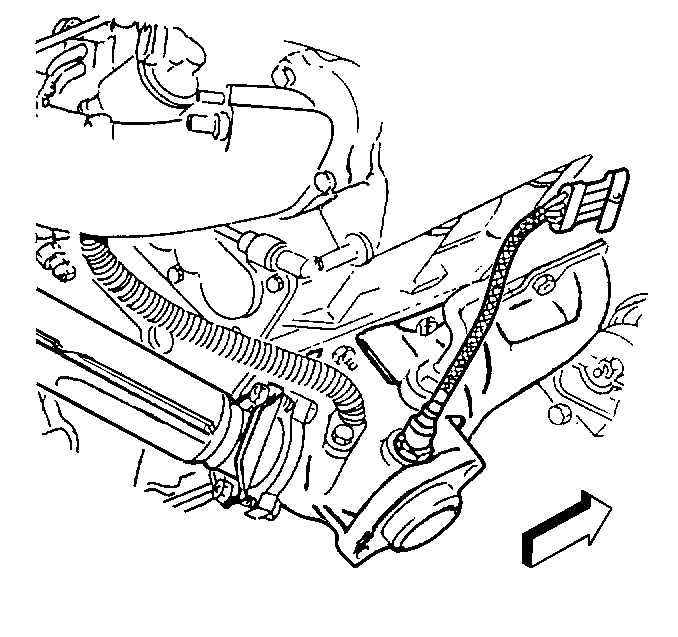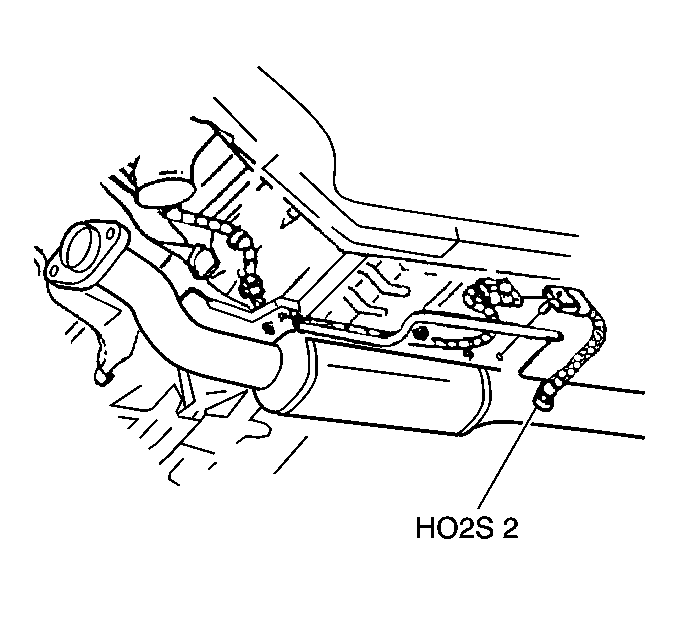Heated Oxygen Sensor Replacement HO2S 1
Notice: The Heated Oxygen Sensors each use a permanently attached pigtail and connector. This pigtail should not be removed from the heated oxygen sensor. Damage or removal of the pigtail or connector could affect proper operation of the heated oxygen sensor.
Removal Procedure
Important: Take care when handling the heated oxygen sensor. The in-line electrical connector and louvered end must be kept free of grease, dirt or other contaminants. Also, avoid using cleaning solvents of any type. Do not drop or roughly handle the heated oxygen sensor/catalyst monitor. A dropped sensor is a bad sensor.
Important: The heated oxygen sensor may be difficult to remove when the engine temperature is less than 48°C (120°F). Excessive force may damage the threads in the exhaust manifold or the exhaust pipe.
- Raise the vehicle.
- Remove the Intermediate iexhaust pipe.
- Remove the Heat hshield.
- Disconnect the sensor electrical connector.
- Carefully remove the heated oxygen sensor.

Installation Procedure
Important: A special anti-seize compound is used on the heated oxygen sensor threads. The compound consists of graphite suspended in fluid and glass beads. The graphite will burn away, but the glass beads will remain, making the sensor easier to remove. New or service sensors will already have the compound applied to the threads. If a sensor is removed from an engine and if for any reason is to be reinstalled, the threads must have anti-seize compound applied before reinstallation.
- Coat the threads of the heated oxygen sensor/catalyst monitor with anti-seize compound P/N 5613695, or equivalent if necessary.
- Install the Heated Oxygen Sensor
- Install the heat shield.
- Install the intermediate exhaust pipe.
- Lower the vehicle.

Tighten
Tighten the Heated Oxygen Sensor to 41 N·m (30 lb. ft.).
Heated Oxygen Sensor Replacement HO2S 2
Notice: The Heated Oxygen Sensors each use a permanently attached pigtail and connector. This pigtail should not be removed from the heated oxygen sensor. Damage or removal of the pigtail or connector could affect proper operation of the heated oxygen sensor.
Removal Procedure
Important: Take care when handling the heated oxygen sensor. The in-line electrical connector and louvered end must be kept free of grease, dirt or other contaminants. Also, avoid using cleaning solvents of any type. Do not drop or roughly handle the heated oxygen sensor/catalyst monitor. A dropped sensor is a bad sensor.
Important: The heated oxygen sensor may be difficult to remove when engine temperature is less than 48°C (120°F). Excessive force may damage the threads in the exhaust manifold or exhaust pipe.
- Raise the vehicle.
- Disconnect the sensor electrical connector.
- Carefully remove the heated oxygen sensor.

Installation Procedure
Important: A special anti-seize compound is used on the heated oxygen sensor threads. The compound consists of graphite suspended in fluid and glass beads. The graphite will burn away, but the glass beads will remain, making the sensor easier to remove. New or service sensors will already have the compound applied to the threads. If a sensor is removed from an engine and if for any reason is to be reinstalled, the threads must have anti-seize compound applied before reinstallation.
- Coat the threads of the heated oxygen sensor/catalyst monitor with anti-seize compound P/N 5613695, or equivalent if necessary.
- Install the Heated Oxygen Sensor.

Tighten
Tighten the Heated Oxygen Sensor to 41 N·m (30 lb. ft.)
